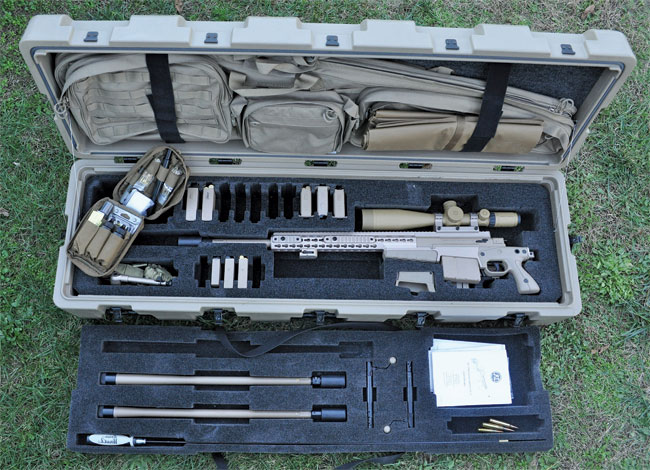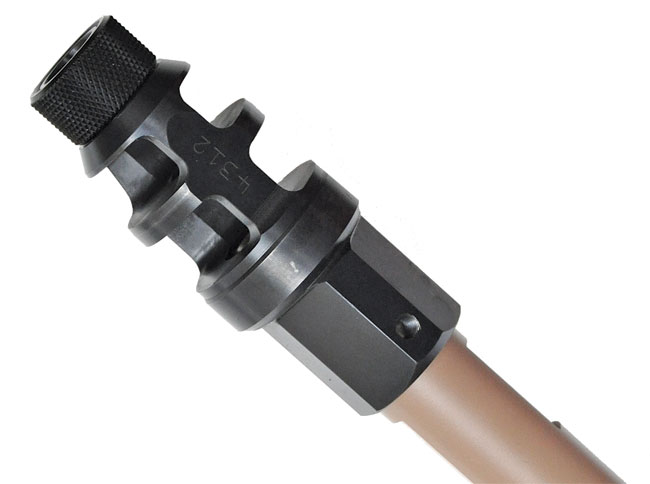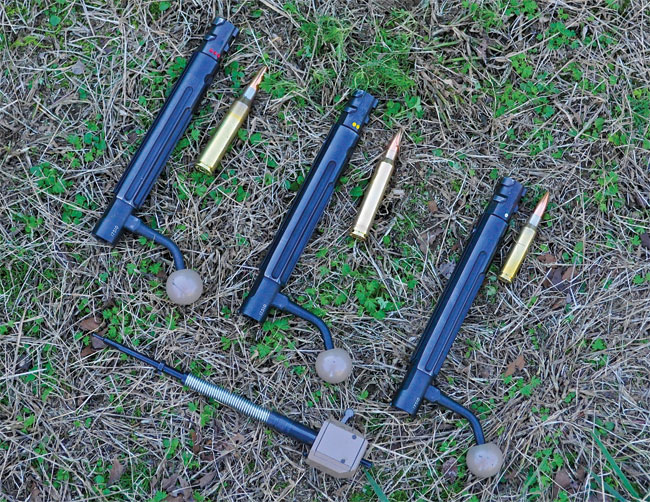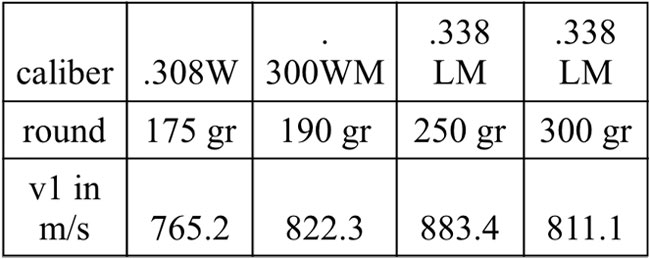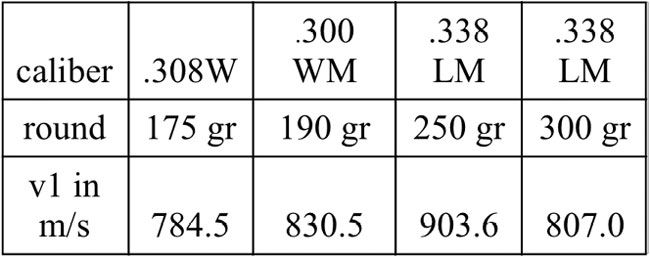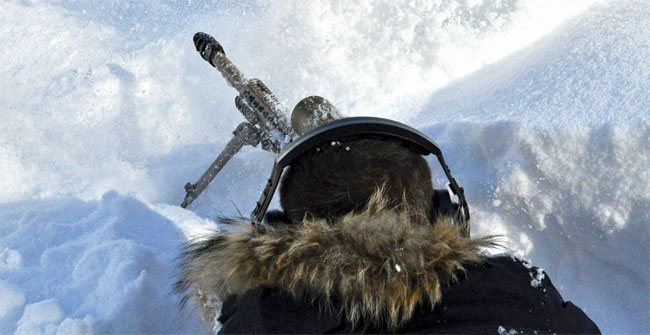Background of the creation of the AX PSR
The Accuracy International AX PSR was developed to compete in USSOCOM’s solicitation H92222-09-PSR2 for a “Precision Sniper Rifle” on 15 January 2009. The essence behind this solicitation and the numerous amendments that followed resulted in a final request for a modular rifle that could be quickly transformed from a 7.62mm to a .300 Winchester Magnum to a .338 Lapua Magnum (not necessarily in that order). The official reason for the solicitation was to possibly replace the MK13, M40 and M24 platforms.
Owning an AX PSR allowed us to put it through its paces as we desired, with no limitations. With the generous contribution of Fiocchi in providing us with 400 rounds of match grade (Fiocchi EXO) ammo and the use of both private and public ranges, we hope to have provided a close up view of this fantastic rifle and what it can achieve despite a major setback due to nature: very heavy snowfall the night before long range testing.
The original SOCOM solicitation stemmed from the fact that it was necessary to change/upgrade the then current sniper platforms in use in the U.S. The principle calibers in use were the 7.62mm that was great for up to a generally accepted effective range of 800m and the .300 Winchester Magnum that was good for a few hundred more meters/yards. The .338 Lapua Magnum (the L115A3 Accuracy International rifle) in use by the British Army was proving to be an exceptionally good extended range round, both in terms of accuracy, range and knockdown power. It clearly did not possess the same terminal kinetic energy as a .50 BMG, however, that is hardly necessary when discussing knocking down the enemy as the .50 BMG comes into its own as an anti-material round.
Briefly, the barrels (one could expect that to mean to specifically change caliber, that is to say, barrel, bolt and magazine) within two minutes, though up to twenty minutes were noted during the go/no-go phase, the same applied to major breakdown of the weapon and subsequent reassembly. The rifle should have a folding stock, overall maximum length not to exceed 52 inches and no individual component to exceed 40 inches and a 1913 rail was a must. In terms of accuracy, using commercial ammunition, a maximum vertical spread (this spread was chosen to at least partially negate the lateral effect of wind) of 1 MOA (minute of arc) from 300 out 1,500 and the intervening 300m intervals was essential, no single 10 shot group should exceed 1.5 MOA. An 80% confidence rate had to be achieved with at least 1,000 rounds fired before any potential failure. The entire platform loaded with 5 rounds should not weigh more than 18 lbs.
An important factor was that after disassembly and reassembly of the weapon, the zero should be maintained and finally, how the sniper platform should be delivered. The major components specifically requested were: the rifle including the barrels, bolts and three magazines per caliber, sound suppressor (not in our case as sound suppressors are illegal for civilian use where we reside), mirage mitigating device, operator manual, sling, cleaning kit, bipod, drag bag and the hard carrying case. All the above in the case the rifle tested meant a total weight (including the scope with no ammo) of about 115 pounds.
Accuracy International
Accuracy International was founded in 1978 by a group of top level competition shooters, most notably a two-time Olympic Gold medalist: Malcolm Cooper. The idea was to produce rifles that had the precision of rifles used in top level competitions as well as have the ruggedness required by rifles used by law enforcement as well as the armed forces. The range of rifles produced are household names for most shooters: AE, AW and the AX series. To the best of our knowledge the only non-bolt action rifle ever produced by the company was the semiautomatic AS50 (as the name suggests, it is a .50 BMG) produced to respond to the request of a certain section of the U.S. Navy. The rifles are used in at least 60 countries under different denominations in some cases, however, they are minor modifications. The L115A3 (.338 Lapua Magnum rifle set an official world record confirmed kill in November 2009 at a range of 1.54 miles or 2.47km). The company is quite right to want to maintain its reputation for being the best producer of sniper rifles in the world.
The AX PSR
The AX PSR has been designed in such a way that changing barrels is extremely simple because of the solidity of the action body and the generous dimensions of the barrel thread (a protective cover is provided for both muzzle brake and barrel thread when not attached to the rifle). The thread has a 13/1 inch twist rate and a diameter of 1.07 inches with a length at either end of the thread and 1.18 inches at the threads. The length of the entire barrel thread section that interlocks with the action is 1.5 inches.
The AX PSR when empty weighs in at 14.5lbs (6.6kg), fully extended it is 49.75 inches (1.26m) long, (well short of the originally required limit) and folded it is 39.5 inches (1.03m) long (just under said limit). The trigger pull is long and smooth and is set at between 1.5kg and 2.0kg.
All the barrels are 26 inches long with four grooves and all have identical muzzle brakes attached (a UK specification in our case, clearly larger than the one for the U.S. market). The barrels have also had a coating of specially treated ceramic paint.
A 4mm Allen (Hex) key is contained in the upper internal part of the cheek piece. It can essentially be used to almost totally dissemble the rifle; just the screws on the scope mount are beyond its ability.
The barrels are made from match grade stainless steel (AISI416) and are all 26 inches long. They are slightly conical with the external diameter at the muzzle being 22 mm (.88 inches) for all three calibers. There are small but significant differences externally in order to identify the barrel even in the dark.
The 7.62mm barrel has a 1 in 12 twist rate and is identified by a single indented white dot near the muzzle; the same applies to the bolt of the 7.62mm. The .300 Winchester Magnum barrel has a 1 in 11 twist rate and is identified by two indented yellow dots near the muzzle; again the same procedure for its bolt. The .338 Lapua Magnum barrel has a 1 in 9.3 twist rate and is identified by three indented red dots near the muzzle and the same applies to the bolt.
This system clearly helps when changing caliber in the dark. The magazines have also been given differentiating marks/forms to avoid loading the wrong magazine especially in the case of two similar in size magazines such as the .338LM and the .300WM. The 7.62mm is a classic double stack magazine with no lip on the bottom, the same shape as for other Accuracy International rifles of the same caliber. The .300WM on the other hand has a pronounced lip at the base, clearly distinguishing it from the larger .338 LM caliber as that magazine is a normal flat bottom.
The muzzle brake is very large and extremely effective. There is very little recoil irrespective of caliber despite the Fiocchi EXO ammunition being quite potent. As a simple test whilst shooting at the gongs, we turned the muzzle brake about 45 degrees. The difference was impressive: with the muzzle brake set correctly, the reticle would stay on target, once changed at 500m range the reticle shifted about four to five meters. Not a great surprise but an aspect that many underestimate when toying with muzzle brakes. At the fore of the muzzle brake there is a ring that can be unwound and a suppressor added as well as unwinding the muzzle brake and attaching one more classically directly to the barrel.
Changing Calibers – Barrels, Bolts and Magazines
This is surprisingly easy and took no member of the team, shooter or bystander more than ninety seconds to change caliber, i.e.: barrel, magazine and bolt and safely stow the exchanged equipment.
First, fold the stock of the rifle by depressing the release button next to the folding joint for ease of subsequent extraction and insertion of a new bolt. Cock the bolt so that the firing pin is clearly visible, then put the safety lever to the first position (the second of the three clearly visible safety circles) and extract the bolt having depressed the bolt release catch. Press the pin bolt and with the bolt in one hand turn the bolt shroud anticlockwise and after just over half a turn, the shroud including the firing pin will simply release. Get the new bolt and do the reverse and insert the new bolt into position and then straighten the stock. The bolts, as is the case with all Accuracy International bolts, are very well designed and made as well as being very robust, 0.9 inches in diameter (22mm). One should not forget the impressive 6 front locking lugs, two sets of three, very solid and zero movement when locked and the bolts move like a dream even just slightly oiled.
Second, for ease of twisting the barrel at a right angle, the rifle was raised and the butt put on the floor after having extracted the Allen key from the cheek piece. After a bit more than a full turn on the barrel clamping screw, the barrel could be twisted by hand and extracted. The new barrel could then be inserted and then tightening the barrel clamping screw using the Allen key. (Clearly, one must be careful not to overdo it and break the threads. The recommended torque is 5.0 to 5.5 Nm.) There is a helpful guide when screwing on the barrel to make sure that it is locked in position before using the Allen key: there is a barrel flange inspection slot painted red: by looking through that slot one can quickly check whether full contact has been made and lock the screw. If the barrel is stuck or stiff to pull out, there is a clear flat area on both sides of the barrel just before the muzzle brake where a 22mm spanner can be used for leverage.
Third, changing magazines is the simplest part. Depress the release catch and extract the magazine and insert the new one. This procedure is simpler for the two magnum calibers as the magazines fit perfectly. However, the 7.62mm magazine requires that an adapter be inserted in the same manner as a magazine. A click will be heard once it is in position as the retaining plunger button becomes clearly visible on the extractor side of the rifle (right hand firing rifle). In order to release the magazine, press the release button and extract the magazine as normal, then use the Allen key to depress the retaining plunger and push the adapter out.
The AX PSR is one of the only sniper platforms, if not the only one from this solicitation, that has ten round capacity magazines as standard for all three calibers with three magazines per caliber as requested provided.
The Rail and Bipod
The rail, as per USSOCOM request, is a 1913 type and made from very light but high resistance alloy. All manner of optics and devices can be attached on all four sides of the rail. There is plenty of space between the rails and the fully freefloating barrels within. The rail can be released very easily by using the usual Allen key and unscrewing two retaining screws locked into the chassis, via the polymer lower chassis. In the U.S., that is sufficient. If using a UK style muzzle brake that should be removed, simply unscrew it with the Allen key and unwind it, this being due to the much larger muzzle brake.
The AX PSR can clearly use any type of bipod that can be attached to a rail. In our case we have the factory bipod for the PSR, which is attached and released by simply depressing the release catch. This particular bipod can be attached at any point along the rail by simply unscrewing the two retaining screws. The bipod legs can be extended like that of a Harris BR bipod and either be used in a fixed position by tightening the star shaped device or free moving for uneven terrain. It is very wide at the base and extremely low allowing for great stability.
The Receiver
This rifle, although highly modular, has one central piece that is essentially produced from a single block of steel. The chassis, action, trigger mechanism and pistol grip are all basically housed in one block. This makes it very robust, obviously having been designed to be able to house the largest caliber – the .338 Lapua Magnum – and it can easily accommodate the other calibers in terms of recoil and pressures. A Picatinny rail has been incorporated onto the action and guarantees more stability for the telescopic sights especially when fixed by the mono block rings by three retaining screws and a retaining lug that fits perfectly in the rail for even more stability and safety.
The Stock
The stock has been made from high grade alloys and polymer. The instant visual difference between this stock and that of the normal AX rifles is that this is skeletal.
The stock, despite appearing fragile, is actually solid and comfortable to grip given the multitude of adjustments that can be had in adjusting the height and horizontal distance of the cheek piece as well as extension of the butt if desired. The butt, too, can be adjusted 360 degrees. The rear grip is also adjustable in a horizontal direction.
The shape of the alloy part of the stock that gives the stock its strength would also seem to have been designed with the tip of the triangle towards the action and two parallel lines going to the butt in order to better spread the recoil pressure. It is clear that the strong and light alloys have been used where mechanical stress/strain is involved and the polymer for “comfort.”
The Scope
The scope mounted on our AX PSR is the same one that won the USSOCOM contract. It is a Schmidt & Bender 5-25×56 PM II/LP/MTC/LT with the addition of an extension with a honeycomb filter. The model mounted on our PSR has the P4L fein (L meaning that the center of the crosshairs can be illuminated) reticle set in the second focal plane. The click values are 1/4 MOA on both elevation and windage turrets. This scope is essentially the same as the classical 5-25×56 PM II/LP apart from the color. It also has a locking function by using the supplied Allen key to block the elevation and windage turrets. The scope without the honeycomb extension weighs in at 1.15kg (about 2.53 lbs.) and is 41 cm long (16.1 inches). The tube is 34 mm thick. On a clear day at 800m, one can see near misses enter the snow in the mountain – not the splash but the a darkish hole of a direct entry into deep snow.
The scope is very robust and the various turrets/drums for parallax, elevation, windage and illumination can all be used easily with shooting gloves in the cold. The same applies to the thick rubber magnification ring as well as the eyepiece diopter.
The Ammunition
We are most grateful that Fiocchi provided us with 400 rounds of very high grade competition ammunition called EXO in order to test the AX PSR. This ammunition has been very specially designed and is produced by hand at the head office factory of Fiocchi in Lecco in northern Italy.
We received 100 rounds of .308W HPDT in 175 gr. and a further 100 rounds of .300 Win Mag HPBT in 190 gr. We then also received two lots of 100 rounds of .338 Lapua Magnum rounds: 250gr and 300gr.
Test Procedure
As we had 400 rounds with which to do a lot of work it was decided to divide the rounds as follows for each of the four lots. Due to the above mentioned limitations and the atrocious weather we could not replicate the original tests, especially talking it out to the full 1,500m:
- 5 rounds to zero the rifle at 100m
- 10 rounds for chronograph tests at the Vigevano shooting range whom we thank for their time and patience. This allowed a basic ballistics table to be created to use as much ammo as possible in the tests in the range and mountains without wasting too much on “climbing” towards the target.
- 10 rds for 2 five shot groups at 100m
- 10 rds for 2 five shot groups at 300m
- 20 rds for shooting at 5×5” gongs at 500m
- 20 rds for shooting at 5 x5” gongs at 600m
- 10 rds for shooting at 5×5” gongs at 800m
- 5 rds were the most that could be spared to correct if the calculations were too far off.
When shooting at the range, we used standard procedure where each shooter attending the range has one hour, therefore, we fired our groups of 40 rds per distance in one hour including changing barrels.
All shooting was done from a prone position using the bipod with the butt against the shoulder with no other form of support such as rear bench rests, sandbags, etc.
An important premise that should be made is that these four hundred rounds are the first that this AX PSR has fired and was taken out of the box. Therefore, there is no breaking in of the barrel, a few rounds to zero the weapon and test the robustness of the rifle by dunking it and the scope in snow filling the magazine, chamber (partially) and muzzle brake with snow. The first round was understandably harder than normal to chamber because of the compressed snow, however, it fired without problem and there were no stoppages and shots were on target.
We had to resort to using gongs as opposed to firing groups onto paper targets as it was physically impossible go across the valley & up the side of the mountain with the targets due to the heavy overnight snow.
Results
All shooting on the mountain was filmed with HD video as we could not physically set up, let alone take down paper targets, hence the sole use of 5 by 5 inch gongs (the smallest available at all ranges).
Below are the average speeds recorded at the Campo di Tiro di Monte Varro: the main atmospherics were as follows: 21F (-6°C), 82% humidity, pressure 892 mb and elevation 996m (3,267 feet).
The following average speeds were taken at the shooting range of Vigevano: the main atmospherics were as follows: 54F (12.3°C), 74.3% humidity, pressure 1000 mb and elevation 116 m (380 feet).
The results in the mountains were surprisingly good seeing as how we had treated the rifle with a good immersion in the snow. It took 3 shots to hit the 500 m gong from our initial 100 m zero. We easily stayed well within the 80% confidence rate required by the USSOCOM go/no go tests, most cases we were at 100%. Most of the shooting took place below the minimum temperature as dictated in the go/no go program: 40F. The gongs were 5 by 5 inches; therefore, even in the worst case scenario we were well within the 1 MOA. From video evidence, half that easily as the strikes are clearly visible especially with the .338LM rounds. The gongs did a number of full 360 degrees that was both gratifying as a shooter and entertaining for those watching.
Then came the range tests involving 2 sets of 5-rd groups per lot at 100m & 300m.
Groupings at 100 m at 16:00-17:00, 26°F, 656 feet, 50% humidity, 1003mb.
.308W: 175 gr 12.0 mm 0.41 moa
.300WM: 190 gr 22.4 mm 0.77 moa
.338LM: 250 gr 24.3 mm 0.83 moa
(TSN Vigevano range – same atmospherics)
.338LM: 300 gr 29.4 mm 1.00 moa
(TSN Vigevano range – same atmospherics)
Groupings at 300 m at 10:00-11:00, 23° F, 656 feet, 64% humidity, 999mb.
.308W: 175 gr 48.0 mm 0.55 moa
without snap 4 rounds in 0.23moa
.300WM: 190 gr 42.0 mm 0.48 moa
.338LM: 250 gr 49.0 mm 0.56 moa
.338LM: 300 gr 46.0 mm 0.53 moa
without snap 4 rounds in 0.26moa.
The follow measurements refer to the maximum vertical spreads, which is one of the principal yardsticks as it could partially negate the effects of wind.
Groupings at 100 m at 16:00-17:00, 26° F, 656 feet, 50% humidity, 1003mb.
.308W: 175 gr 12.1 mm 0.41 moa
.300WM: 190 gr 13.3 mm 0.46 moa
.338LM: 250 gr 20.3 mm 0.70 moa
(TSN Vigevano range – same atmospherics)
.338LM: 300 gr 22.2 mm 0.76 moa
(TSN Vigevano range – same atmospherics)
Groupings at 300 m at 10:00-11:00, 23° F, 656 feet, 64% humidity, 999mb.
.308W: 175 gr 47.4 mm 0.55 moa
without snap, 4 rounds in 0.23moa
.300WM: 190 gr 34.4 mm 0.39 moa
.338LM: 250 gr 37.7 mm 0.56 moa
.338LM: 300 gr 36.4 mm 0.53 moa
without snap, 4 rounds in 0.20moa.
All the targets have been legally certified and the shooting director at Monte di Varro also confirmed the hits as well them being captured via HD video. Clearly, the groupings are not the tightest, however, as always, the principal error is down to the shooter
Conclusion
Testing a number of AW series rifles we were both rather skeptical of the robustness of such a skeletal design and the accuracy of having a multi-caliber firing platform not to mention not being fans of folding stocks. After these tests, we are glad to say that we both misjudged the rifle on all counts and believe it to be a superb sniper platform. We had a few days of total freedom and 400 rounds to test the AX PSR in a variety of atmospheric conditions and height elevations and it proved superb all-round.
One final thanks must go to Accuracy International for such a outstanding rifle that when it was zeroed at 100m all three caliber rounds ended up in the same hole. Just as pleasing was the fact that at 300 m there was never more than a 10 cm (4 inch) difference in point of impact when firing one round per caliber at the same target. We had initially been worried about how such different calibers with their varied ballistic properties could be fired in a user friendly manner with just one scope.
– – – – – – – –
We would like to thank the shooting range of Campo di Tiro di Monte Varro (the mountain range), especially Ernesto Fabris and Battista who risked life and limb to get myself, my colleague and the spotter up the mountain where no one else could. Mr. Luciano Turani owner of Armeria 911 for kind permission for using their range and facilities and allowing us free reign.



